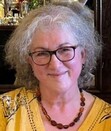Debbie Young's Blog, page 5
July 31, 2024
In Conversation with Jean Gill, Author in Multiple Genres
In my last post of each month I’m in conversation with an author friend, each time on a different topic that I think will interest my readers. This month my guest is the prolific and versatile Jean Gill, who writes across an extraordinary range of genres, with considerable skill in each one. Whatever kind of books you prefer to read, Jean’s catalogue is bound to contain something that will appeal to you.
Debbie: Many authors specialise in a single genre, confident of the themes and tropes required to please readers. As Jean knows, I’m primarily a cosy mystery author, working in a field where reader expectation is clearly defined. It would be much harder to write across multiple genres. Jean, did you set out to write across multiple genres, or did that impulse evolve over time?
Jean: Over time, definitely. Four decades in fact – what a frightening thought!
Debbie: What genre was your debut book in?
Jean: Poetry. I had two poetry books published by the National Poetry Foundation in 1988 and 1996 before I turned to prose when I was forty and wrote my first novel.
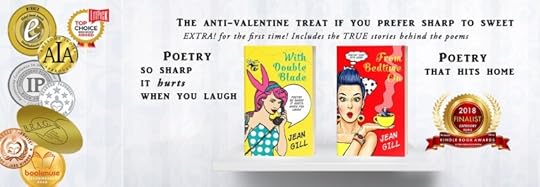 Jean has won many awards across various genres
Jean has won many awards across various genresDebbie: Which genres have you written in so far, and what appealed to you about them?
Jean: I’ve always had too many ideas, and each one cries out to be expressed in a particular form, so I’ve written in a crazy number of genres. Most readers will know me for my medieval fiction but I’ve also written poetry, plays, a cookery book, a memoir, a dog book, fantasy, second-chance love, WW2 military history, teen fact/fiction and even plays for stage and for television.
 More evidence of Jean’s versatility
More evidence of Jean’s versatilityDebbie: Are there any more genres you haven’t yet embraced that you planned to tackle, and if so, why?
Jean: I hope not! But genres find me. Some stories just insist on being written a certain way. If I was traditionally published or relied on my writing income to buy dog food, I would not have the freedom to commit commercial suicide on a regular basis. I have that freedom because of self-publishing, and thanks to my previous career in education, my age – sixty-eight and a pensioner – and my husband’s total support for what I do.
Debbie: What is the greatest challenge of writing in multiple genres?
Jean: Starting over in every aspect of a different genre: writing style and reader expectations, cover branding, research, marketing and reaching new readers. As you know, readers tend to stick with a genre they know they like, and Jean Gill’s readers can get quite confused.
Marketing is genre specific, so that’s more work, and advertising bots get confused too. Distribution sites don’t know which readers would like a Jean Gill book. My most popular book is Someone To Look up To, written from the viewpoint of a Great Pyrenees dog but if you loved that, you wouldn’t necessarily love an eco-fantasy YA novel.

Debbie: What’s the greatest benefit of writing in multiple genres?
Jean: Bringing someone’s story to life, the way I feel it should be told! Each book has emotional importance for me, and I put a lot of work and time into each one. I always hope that readers will respond to that on some deep level, and I know many do.
Debbie: Your background is in teaching English Literature, which presumably covered a very wide range of reading matter. How has your former career shaped you as a writer?
Jean: As a senior teacher, I once co-interviewed young graduates for Swansea University’s teaching qualification and worried about their innocence.
‘Why do you want to be a teacher?’
‘Because I love Jane Austen.’
Jane Austen would not be the only casualty if that student did not realise quickly that you teach pupils, not your own favourite novelist. Most of the pupils in my schools were 11-16 year olds who would rather be elsewhere and many of them had literacy problems. Teaching them mattered just as much as teaching my ‘Jane Austen’ students.
The classroom taught me how to engage with a variety of real readers, with stories that hooked them. If I didn’t, the reaction could be brutal. And what better stories to hook them than those they’d written themselves? The link between writing and reading was intrinsic to motivating my students and made me read widely, modern teen books, non-fiction, everything that might go down well in lessons.
I still read widely and am shocked by any novelist who ‘doesn’t have time’ to read fiction.
Debbie: Me too!
Jean: I used to write for my pupils too and we got creative together. Fun.
Debbie: You’re a long-established ex-pat, resident in France. Are you also now a French citizen? How has living immersed in a different language and culture impacted your writing?
Jean: I prefer the word ‘immigrant’ and have lived in France for 21 years now.
Debbie: Good point – ex-pat is quite a negative term, saying what you used to be, and possibly implying you may change your mind. Immigrant indicates positive forward intention of making France your long-term home.
Jean: I applied for citizenship three years ago, and the queue is running at four years or more before you know whether even more documents are required, so there’s a long way to go to even reach the interview stage. Meanwhile I’m a FRUKC: French Resident UK Citizen.
I’ve always lived in a different language and culture, and this has definitely had an impact on my writing.
Always the outsider was painful when I was a child, but I’ve grown to like and use that point of view. My main characters are often misfits and rebels.
I’m a soldier’s daughter, so we moved house and often country, staying a maximum of two and a half years in any one place, sometimes moving after six months. My parents were Scottish, but we never lived in Scotland. I moved to Wales from Yorkshire when I was twenty-two and lived there for twenty-five years so I adopted Wales as ‘my’ country. I’m never sure Wales adopted me back!
My French is good, and my Welsh is minimal, but I love the ‘colour’ that different languages add to dialogue so I try to give that flavour to my books.
As an aside, I reached the second stage of becoming a writer for Eastenders after an ITV course for budding screenwriters, on which I won a place by writing a ten-minute television script. I’d never actually watched Eastenders, so it’s a good thing I didn’t make the cut. Eastenders was the top-earner for writers at the time and, although I loved my work, I really wanted more time to write. I was forty-four at the time, English Advisor for Neath Port Talbot, responsible for English and literacy for 4-19 year-olds in 86 schools, in a county without one bookshop.
Debbie: Wow!
Jean: Instead of writing for television, I went independent as an English Consultant, travelling all over England and Wales. The risk paid off, enabling me to continue both my paid work (which I loved) and writing my books (which I also loved). Then, when I was forty-seven, I moved to France with my husband, to write full-time and – as it turns out – to become a photographer.
Most of my books are set at least partly in Wales or in France in the landscapes I love best, but my writing has taken me to unexpected places, including Sicily and the Holy Land, neither of which I’ve been to in the real world. I do hope to go to Sicily in October for my version of R & R, ‘romance and research’. My man checks out my research travel plans hopefully but ducked out of Orkney. He likes sunshine.
Debbie: Orkney is wonderful! I went there a few years ago, on a touristy day-trip from John O’Groats, and fell in love with it. I’d love to revisit for longer. Now, when deciding which book to write next, how do you choose the genre?
Jean: If I’ve started a series, I stick with it until it’s finished. When that happens, I dive into my drawer-full of ideas and one of them shouts the loudest. You know what it’s like – writing a book is a huge commitment – ten years for ‘The Troubadours’.
I feel the weight of books not written, so that choice is a crossroads.
An example of this intuitive (AKA mad) process was how YA fantasy novel The Queen of the Warrior Bees came to bee (!) I was pushed into it by over fifty bee-stings in the head, a friend’s suggestion for a story, and an online recommendation for fake grass.
Let me explain. I’m a beekeeper and a stupid mistake led to me being followed from a hive, by angry bees. I thought I had one bee inside my visor so I took down my protective hood. All the bees following stung me and the sheer volume of poison caused a severe reaction. I had time before the shock set in to see a doctor and get an epinephrine injection.
My friend Babs Morton said, ‘that would make a good story. What if someone was stung by bees and gained superpowers?’ I didn’t unfortunately gain superpowers,but the idea for Mielitta was born.
Then, as a beekeeper, I grew angry at the trend for fake lawn in people’s gardens. How are insects supposed to live? Why are people destroying the natural world as if we’re not part of it? And so the story took shape – or rather shifted shape, with a heroine who can shift into a bee and a chilling pseudo-medieval world in which Nature is the enemy. The Natural Forces trilogy was born!

All my books have a story like that behind them, some ‘inciting incident’, to use a term other writers use. I never know what the inciting incident is in my books but in the stories behind them, it’s obvious.
Debbie: Aspiring writers are often encouraged to read widely in their chosen genre to acquaint them with best practice (and to avoid the worst!) What kind of reading habit would you recommend to anyone seeking to write in multiple genres – must they read widely in all of them?
Jean: That’s certainly true of me. I’ve never written in a genre I don’t read. Or in one I don’t like.
Debbie: Which is your favourite of all your books? Which is the best selling?
Jean: The cruellest question! I can’t choose but Someone To Look Up To is my husband’s favourite, and is a bestseller in both French and English. I mostly live in the twelfth century as it’s more civilised than this one, so one of my six medieval novels might make favourite status.

Debbie: Which book – in any genre – would you like to have written? Mine’s Graham Greene’s Travels with my Aunt.
Jean: That’s such a good choice for you! These Mortals by Margaret Irwin. It’s a fable about a girl discovering fake friends and true love. Her companions are a raven, a snake and a cat, and she can walk on moonbeams. I always thought it was about me.
Debbie: How do you switch mindset when finishing a novel in one genre and starting the next in a different one? Do you need a palate cleanser – and if so what is it? (I tend to write a short story or novelette between novels in different series.)
Jean: I allow myself a writing break. I binge-read and spend time on a photo project.
Debbie: What writing habits work for you? Do you have a typical routine for a writing day?
Jean: I’m a morning person, and I love to take my ipad (with keyboard) into our big garden and write out there, while my pointer Rtemis runs around. I can write while travelling, which is useful – on a train, on a plane, in a hotel room. I can’t write if I only have half an hour, or if somebody is interrupting me.
Debbie: What’s the best writing tip you’ve ever received that you would like to pass on to new, aspiring writers?
Jean: ‘Don’t get it right; get it written.’ We all work in different ways. I know you write an outline and expand, whereas I scribble unintelligible phrases occasionally, as I see scenes, then lose myself in whatever writing comes – but the editing comes after the writing. Get it written!
Debbie: Your latest series is set in Orkney – a long way from where you live now. What made you home in on this remote part of Scotland?
Jean: In Song at Dawn, Orkney’s Jarl (Earl) visited Narbonne in France on a voyage as a pilgrim to Jerusalem in 1150. This was a small scene in the novel, but the extraordinary event did take place and something attracted me to Orkney. My mantra is ‘magic happens’, so I followed that instinct and took a solo photo-trip to Orkney from a Historical Novel Society Conference in Glasgow in 2018.
When I visited Maeshowe pre-historic burial chamber and realised I was surrounded by twelfth century Viking graffiti, written by the actual men on that pilgrimage, and I saw the dragon carved on the wall, magic happened. I could see the scene – and The Ring Breaker was born.

I bet you have had something similar, where a story said, ‘Write me’ or where you came across real history that you thought you’d invented in your novel.
Debbie: Yes, absolutely – including for my debut novel, when a chance conversation with a friend about life in my Cotswold village prompted me to joke that if, as in Midsomer Murders, there was a murder at our annual village show, we’d give a prize for it, as we do for just about everything else. And so a title – Best Murder in Show – came about, the first in a long-running series (nine books and rising)!
Jean, publishing often require authors writing across different genres to use a different pen-name for each so as not to confuse or disappoint reader expectations, eg when Agatha Christie wasn’t writing about crime, she wrote as Mary Westmacott. Personally, when I find an author I like, I want to read everything they’ve written, regardless of genre, eg Graham Greene‘s political thrillers and his more light-hearted “entertainments”, as he called them. What’s your approach to pen names?
Jean: I wish everyone was like you as a reader. Pen-names would be too complicated for me.
I asked my readers whether they would prefer me to have different names/ different newsletters for the various genres and they told me ‘We’ll figure out which bits interest us. You just spend your time writing more books!’ That suits me.
Debbie: You’re also a professional photographer. How does your work in that field influence your writing life?
Jean: When I write, I see images, and when I take photos, I see stories. You won’t be surprised to know that I am multi-genre as a photographer! I know you often speak of ‘filling the well’ and about the way writing can drain an author, and if I do a photo-shoot, I feel refreshed re writing – and vice versa.
Also, photography gives quick results compared with writing. I take up to two years to write a big historical novel so it’s a long wait to get reader reaction. Whereas I get responses to photos quickly, so that’s good for motivation – if they’re positive responses!
Debbie: For someone new to your work, which book of yours should they start with?
Jean: As this is about me being multi-genre, here is a practical demonstration of how difficult that is to pull off!
Incidentally, Debbie, I followed up your brilliant suggestion, and my newsletter subscribers get a free ebook which is a memoir, exclusive to my readers, about my life in France and the stories behind some of the different genres I write – a way to help readers choose their first Jean Gill book!
Debbie: Hurrah! And if that free ebook appeals to any of my readers here, just go to Jean’s website at www.jeangill.com and follow the simple instructions to get your own free copy. Now, back to Jean’s recommendations…
Jean: If you like:
dog stories – read Someone To Look Up To https://books2read.com/someonemedieval fiction like Game of Thrones with real history – read Song at Dawn https://books2read.com/SongYA fantasy, alternative fairy tales, elemental magic and a dash or romance in a medieval, dystopian setting – read Queen of the Warrior Bees https://www.books2read.com/QueenBeefun facts for all left-handers and a teen story of friendship against prejudice – read Left Out https://www.books2read.com/LeftOut
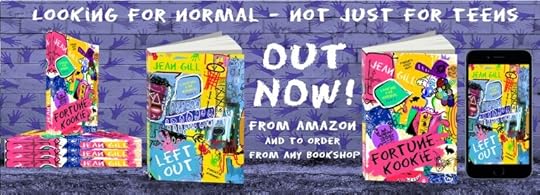
Debbie: Well, that’s everybody’s holiday reading sorted! Thank you so much for joining me today, Jean, and enjoy your trip to Orkney.
And now I must get back to my own writing, in my familiar cosy mystery groove – the sequel to Death at the Old Curiosity Shop, which launches on 11th October and is now available to pre-order…
July 17, 2024
A Grandmother’s Wisdom
In my column for July 2024’s Hawkesbury Parish News, I’m feeling nostalgic…
After picking up a book by Joyce Grenfell called Nanny Says, I started reminiscing about the memorable things my grandmother used to say.
Born in 1900, Grandma spoke an English that predated the homogenisation of our language by television and the internet. Raised in the days when people had to make their own entertainment, Grandma won prizes for recitation. Loving language from an early age, she taught me to play Scrabble and other word games. When my family went to tea with her, she would read aloud to us her favourite passages from Punch, the satirical magazine.
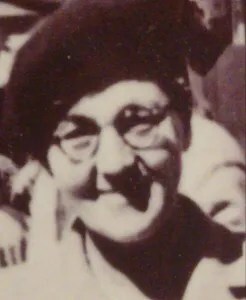 My beloved Grandma
My beloved GrandmaI liked the way she used archaic words that in her youth had been the height of fashion. Instead of calling us “dear”, she called us “ducky” (first added to the dictionary in 1897). When Grandpa asked me if we’d be going on a charabanc on our school trip, I didn’t know what he meant, but when he was courting Grandma, charabanc trips were all the rage.
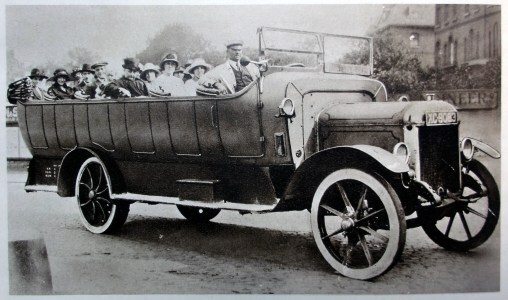 The kind of charabanc that my grandparents might have used in the 1920s (photo by Harold F B Wheeler, public domain. via Wikipedia)
The kind of charabanc that my grandparents might have used in the 1920s (photo by Harold F B Wheeler, public domain. via Wikipedia)Whenever I got the giggles, Grandma would exclaim, “You’d laugh to see a pudden crawl,” which made me laugh even more. I never discovered that saying’s origin. Perhaps it was a music-hall comic’s catchphrase.
She also had some memorable phrases of her own. At the tea-table, if the milk-jug ran dry, she’d say, “I’ll go and ask the cow”, before taking it to the kitchen to refill. For years, my sister thought there actually was a cow in Grandma’s kitchen.
If something that she’d had for a long time broke or wore out, she’d console herself with this philosophical thought: “It doesn’t owe me anything.” I said this myself only last week when replacing my car with over 100,000 miles on the clock.
 Goodbye, dear Panda – you served me well
Goodbye, dear Panda – you served me wellCatching me looking in the mirror, Grandma tried to ward off vanity by telling me, “Stare in the mirror too long and you’ll see the devil looking over your shoulder.” It worked: I still sometimes give a backward glance after gazing at my reflection, just to be on the safe side.
If I made a smart comment, her gentle reprimand was, “You’re so sharp, you’ll cut yourself”, which made me rein myself in.
If visitors were late, Grandma would say, “Let’s boil them here,” and put the kettle on. The visitors would soon arrive, as if she’d conjured them up with a pot of tea. I was so convinced that her scheme worked that I often do it myself.
 (Photo by Bongo via Morguefile)
(Photo by Bongo via Morguefile)Only as I’m writing this do I realise the secret behind her magic: the act of making tea simply passes the time and distracts you from boring clock-watching. So much for my being sharp.
In Other News…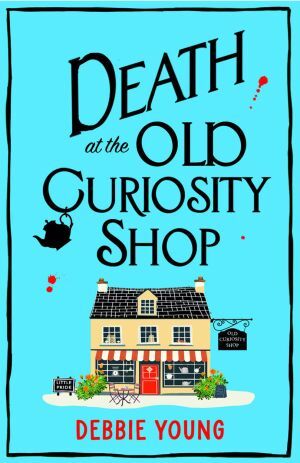 Coming soon! The first in my new Cotswold Curiosity Shop series of cozy mysteries
Coming soon! The first in my new Cotswold Curiosity Shop series of cozy mysteriesPerhaps because of the close relationships I’ve always had with older people, including all four of my grandparents, I love writing about elderly characters, whom in my books are usually portrayed as wise sources of counsel to younger characters. I’ve had particular fun dreaming up an older advisor for the protagonist of my new series, Alice Carroll, who inadvertently becomes the proprietor of a derelict bric-a-brac shop in the Cotswold village of Little Pride.
However, I don’t want to tell you any more about this older advisor, as it would be a plot spoiler! You’ll have to read the first book in the series, Death at the Old Curiosity Shop, to find out…
Death at the Old Curiosity Shop will be launched in all formats (paperback, ebook, hardback, large print and audiobook) on 11th October, published by Boldwood Books. It will be available for pre-order from all the popular online retailers including Amazon here – or you can order it from your friendly local bookshop or library.
July 10, 2024
Bring Back Colourful Cars!
Last month, the need to replace my faithful old black car – and the dearth of any more colourful ones in my price range – inspired me to write about car colours in my column for the July/August double edition of the Tetbury Advertiser .
When did British car buyers become so dreary? Shopping for a second-hand car to replace my defunct Fiat Panda, I’m astonished to find the choice of colour so limited.
 I was sad to say goodbye to Po, my Fiat Panda (named after the “Kung Fu Panda” character) after it gave up the ghost at over 100K miles
I was sad to say goodbye to Po, my Fiat Panda (named after the “Kung Fu Panda” character) after it gave up the ghost at over 100K milesAdmittedly, my Panda was black, which made its boxy shape reminiscent of a classic London taxi, much to my delight. But in the past, I’ve driven a pillar-box red MG Metro, burgundy and pine-green Renault 5s, and a forest green Rover something-or-other whose name escapes me.
So after nine years with a black car, I was contemplating something more colourful. A soft green or mauve would look prettier parked outside my Cotswold stone cottage, while yellow would delight anyone playing the Yellow Car travel game (shout ‘Yellow Car’ when you spot a yellow car).
Any of these colours would also make my car easier to spot in a car park.
Choosing to support a local long-established family firm of car dealers inevitably limited my choice of make and model, but I hadn’t expected the colour range to be so narrow: black, white or grey.
In the Olden Days…Back in the 1990s, when I worked as a PR consultant, I was pleased to make national headlines about colourful cars. “Nation’s drivers prove patriotic” was the gist of the story, sharing my client’s research that red, white and blue cars were most popular with its customers.
Yet in 2023, according to the Society of Motor Manufacturers and Traders, over two-thirds of two million new registrations were for grey, black, or white cars, only 11,800 for yellow, and a pitiful 210 for pink.
Hard evidence is everywhere. Next time you’re driving on a motorway, you’ll notice almost all the cars are black, white or grey. When no-one’s using their indicators or brake lights, against the tarmac background, the traffic looks like black-and-white film footage.
What has happened to turn our tastes monochrome?
Is the about-face an indicator of tough times, like the rise and fall of hemlines in line with the strength of the economy? Might the results of the British election lead to a revival of more colourful cars?
In the end, I plumped for a steel grey Citroen C1. (Don’t get me started on .) The monotony of the grey exterior was slightly relieved by a thin red stripe in the upholstery, so I christened the car Poppy, so that at least its name is colourful.
Then yesterday, I had a welcome surprise. Getting out of my car in bright sunshine, I noticed that the grey metallic paint, viewed through my polarised prescription glasses, sparkles with thousands of tiny dots in all the colours of the rainbow. Perhaps I should rename it Joseph, after he of the coat of many colours.
Now all we need is a sunny summer to allow me to repeat the experience.
Whether you’re planning a staycation this holiday season or sun-seeking further afield, I wish you a wonderful summer.
Sophie Sayers’ Colourful Car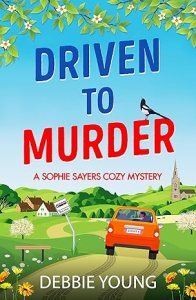 You can spot Sophie coming a mile off in her bright orange car! So easy to find in a car park too…
You can spot Sophie coming a mile off in her bright orange car! So easy to find in a car park too…I had fun choosing a colourful car for Sophie Sayers when she learns to drive in Driven to Murder, the latest addition to my cozy mystery series about her. When she passes her test after an eventful series of lessons with a multitude of instructors, she treats herself to a bright Fiat Panda in “Sicilian Orange”, as whoever dreams up the paint names at Fiat has christened it. As events turn out, it’s just as well she rejects the salesman’s suggestion of a subtle green to blend in with the landscape… but you’ll have to read the book to find out why!
The ebook of Driven to Murder is currently just 99p on Amazon UK, and I’m guessing similar prices worldwide (my publisher sets the prices for my novels, which is why I’m not sure) It’s also available in paperback, hardback and audiobook – so however you prefer to enjoy your summer reading, there should be a format to suit you!
June 26, 2024
In Conversation with Vine Leaves Press
As regular readers of this blog will know, in my last post of each month this year I’m in conversation with an author friend. Well, this month, you’re meeting not one but two of my author friends, Jessica Bell and Amie McCracken, speaking about the small but mighty independent publishing company that they run, Vine Leaves Press.
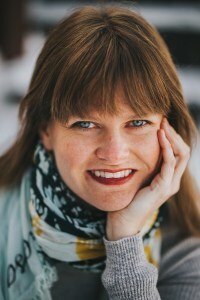 Amie is Vine Leaves Press’s publishing director
Amie is Vine Leaves Press’s publishing director Jessica is Publisher at Vine Leaves Press. (Photo by Giannakakis Tasos)
Jessica is Publisher at Vine Leaves Press. (Photo by Giannakakis Tasos)Years ago, I used to be a reviewer for Vine Leaves Press, so I can vouch from personal experience for the quality and diversity of their books. Jessica and Amie are both multi-talented writers, who have published many of their own books also, and between them they have all of the skills that any publishing company needs:
editing, formatting, design, production, distribution and marketing.
I particularly wanted to share with you the diversity of their books, one of many factors that makes their work stand out from mainstream publishers, who so often pay only lip-service to representation.
At the end of the interview, you’ll find an invitation to submit YOUR manuscript to Vine Leaves’ International Voices competition – but you’ll have to hurry, as the deadline is Monday 1st July!
Debbie: Hi, Jessica and Amie, I’m so pleased to be sharing here with my readers the great work that you do. Vine Leaves Press is renowned as a platform for diverse voices – such an important topic in today’s publishing industry. Please tell us first a little about how VLP came to be, and its history and achievements.
Jessica: Vine Leaves started as a literary journal in 2011. It was a LOT of work to maintain, but we were lucky to have some fabulous volunteers working for us, and so we stayed on our feet until 2017. In 2014, we started the Vine Leaves Vignette Collection Award, and that’s how we published our first book, the winner of the competition, Amanya Maloba, author of Harvest.
So, becoming a book publisher felt like a natural progression from that point. Now we have around 150 backlist books still in print, some of which have won literary awards, and 30 new titles coming out every year.
For the last few years, we have been inundated with submissions every time we open our doors. Last year (2023) we opened to submissions at the end of September, and between then and February 2024, we received over 500 queries, from both authors and literary agents.
We are now closed to general submissions again until October of 2024 so we can catch our breaths, and our publishing schedule is currently full until mid-2026. We’ve just started building our own store now and are hoping to push direct sales through our own website, since only distributing to retailers like Amazon is getting more and more expensive by day and is not very profitable to us as a business, or our authors. Did you hear about SPD closing? The cost of publishing today is hitting businesses hard.
Debbie: We are now such a mobile society and also much more open about different kinds of diversity eg racial, gender, sexuality, neurology. Why is traditional publishing still so straight/white/middle class? What needs to happen for that to change – if indeed it can change?
Amie: So much of this goes back to history and culture—and of course money. The prevailing society in the arts is still the white colonists.
Many industries are experiencing growing pains in diversifying. Publishing is no different, especially because it has predominantly always been a white male centric business.
I have no doubt it will change, as the internet has opened up the world to how many voices actually exist. And I cannot wait to help make this happen. It might be slow, but it is steadily on its way. You can see this in how independent publishing has gained traction in the last few decades. So too will diversity.
Debbie: How is the indie movement – both small indie presses like VLP and indie/self-publishing authors – leading the field in representing diverse voices?
Jessica: I think we’re more willing to take risks. Yes, we need to make money, but we’re not bound by targets that are set by board members, and pigeon holes re genre that are set by the industry so that a book can fit comfortably on a specific shelf in a bookstore. We make our own rules and bend to meet them.
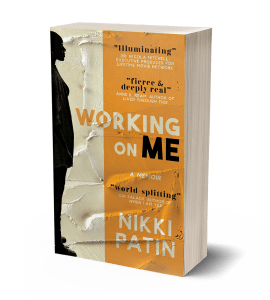 For example, one of our latest releases, called Working on Me, chronicles the dysfunction and lore of a Black Russian Jewish interracial family on the far south side of Chicago, and the resulting trajectory of its prodigal child: multifaceted, multidisciplinary artist, performer, and sexual and domestic violence survivor Nikki Patin. Patin’s prowess as a poet and songwriter is reflected in prose that is brutal, beautiful, and brave.
For example, one of our latest releases, called Working on Me, chronicles the dysfunction and lore of a Black Russian Jewish interracial family on the far south side of Chicago, and the resulting trajectory of its prodigal child: multifaceted, multidisciplinary artist, performer, and sexual and domestic violence survivor Nikki Patin. Patin’s prowess as a poet and songwriter is reflected in prose that is brutal, beautiful, and brave.
At the sight of a submission like that, we get excited. A literary agent would too, I imagine, but then it would hit them that they wouldn’t be able to sell it and have to turn it away.
Debbie: So often authors and publishers pay token gestures to diversity eg making sure there’s one foreign name or one gay character in a book. How do you make sure your books are genuinely representative of true diversity?
Amie: By making sure that the authors we take on have either the personal experience, or have done their due diligence to make sure those voices are properly represented. It is frustrating when topics get shoe-horned in just to meet the quota. Readers aren’t idiots. They know when that’s been done. So we seek authentic voices or make sure that we have sensitivity readers to ensure the facts and emotions are authentic.
Debbie: Authors can submit directly to VLP without an agent – which presumably is another way of increasing diversity, as agents aren’t able to weed any out along the way. What proportion of submissions are from authors who might otherwise struggle to find representation in the traditional publishing sector?
Jessica: Most of our submissions are from authors directly. Probably 90%. The last two or three years has seen an increase in agent submissions.
Debbie: You are way oversubscribed in terms of submissions. How do you choose which books make the cut? Do you consciously choose diverse voices or do they tend to be better submissions because they’re more original?
Jessica: We choose based on whether the author has a unique and authentic voice, whether the subject matter is suitable for our press, and whether the writing is strong.
Diversity comes naturally when that’s what you’re looking for. And it’s clear from the books on our website re what books we want.
That said, we do not exclude work written by white middle-class people about white middle-class people. It’s all about voice and perspective.
Debbie: How can people submit manuscripts to you and what are your top tips for gaining your attention?
Jessica: Our submission guidelines are here: vineleavespress.com/submissions. If you start your query off with one thing that sets your book apart from everyone else’s, then you’ve got our attention.
Debbie: If you could choose a single VLP book that you would love more people to pick up and read, which would it be? Which books representing diverse authors would you recommend to new readers?
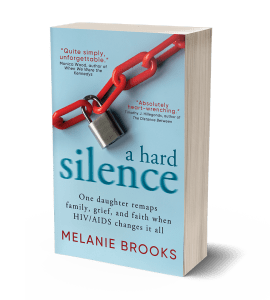 Amie: How can you do this to me? To choose between so many beautiful stories? Goodness. Well, I’m going to bend the rules a bit. There are three memoirs that had me laughing and crying and generally heart-broken in a beautiful way. A Hard Silence by Melanie Brooks, Prepare for Departure by Mark Chesnut, and Were You Close? by Anne Pinkerton.
Amie: How can you do this to me? To choose between so many beautiful stories? Goodness. Well, I’m going to bend the rules a bit. There are three memoirs that had me laughing and crying and generally heart-broken in a beautiful way. A Hard Silence by Melanie Brooks, Prepare for Departure by Mark Chesnut, and Were You Close? by Anne Pinkerton.
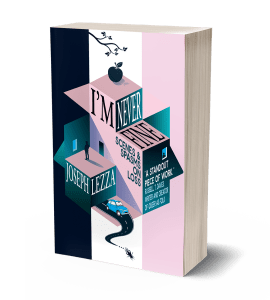 We have a few bestsellers and a few upcoming books that are really hard-hitting. I’m Never Fine by Joseph Lezza is a memoir, an autopsy of perceived missteps, a conclusion to unfinished conversations, and a reframing of flawed judgments through the eyes of a young man in search of a feeling.
We have a few bestsellers and a few upcoming books that are really hard-hitting. I’m Never Fine by Joseph Lezza is a memoir, an autopsy of perceived missteps, a conclusion to unfinished conversations, and a reframing of flawed judgments through the eyes of a young man in search of a feeling.
 Working on Me by Nikki Patin is a memoir that chronicles the dysfunction and lore of a Black Russian Jewish interracial family on the far south side of Chicago.
Working on Me by Nikki Patin is a memoir that chronicles the dysfunction and lore of a Black Russian Jewish interracial family on the far south side of Chicago.
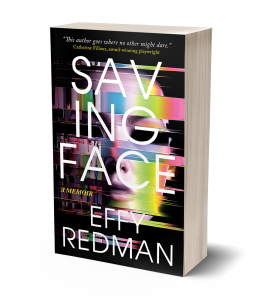 And Saving Face by Effy Redman is a memoir about living with a rare condition of face paralysis. It is a searing personal tribute to anybody who has ever felt like an outsider.
And Saving Face by Effy Redman is a memoir about living with a rare condition of face paralysis. It is a searing personal tribute to anybody who has ever felt like an outsider.
Debbie: What do you find the most rewarding about publishing truly diverse voices?
Jessica: The fact that they are generally overlooked by the mainstream and that we are able to give these authors a real chance at being heard.
Debbie: What’s the best way for readers to get hold of VLP books?
Jessica: Please buy directly from us via the “Our Store” tab on our website: vineleavespress.com. This store is new at the moment, so there are only a few titles there. We are currently getting our back list in order to be available too.
Debbie: When you’re motivated by principles rather than profit, it must be hard work to keep the press going. What’s the best way for readers to support what you are doing, other than by buying VLP books?
Amie: We have always said that the day we don’t have our hands on the production of each and every book that comes through our press is the day we don’t want to be doing it anymore.
Vine Leaves is done out of love and hard work. So that means it would be ever so helpful to have readers share the books they love with their family and friends and even wider across the universe.
We also have an option to donate to Vine Leaves, whether one time or on a subscription basis with the chance to get access to our newest releases. You can do so here: www.vineleavespress.com/donate.html
Debbie: Jessica and Amie, thank you so much for joining me in conversation here today. I’m excited to raise awareness of Vine Leaves Press and the great work you do with my readers, family and friends.
Would you like to write for Vine Leaves Press?If so, here’s a timely competition for you to enter – but hurry, as the closing date is on 1st July 2024!
Click the link below to find out more about the 2025 International Voices in Creative Nonfiction Competition:
https://www.vineleavespress.com/international-voices-in-cnf.html

June 25, 2024
The One-Bag Wonder
Decluttering features in my next novel, Death at the Little Curiosity Shop, the start of my new cosy mystery trilogy – and it’s been front of mind lately for other reasons too, as I explain in my June column for the Tetbury Advertiser.
***You’ll find a sneak preview of Death at the Little Curiosity Shop – and a link to preorder it – at the foot of this post. ***
On return from a few days in Suffolk, where I’ve been helping my 93-year-old aunt declutter her house, my cottage seems terribly crowded. Having lived here for 33 years, I’ve allowed far too much stuff to accumulate.
Conscientious about recycling things like packaging and kitchen waste, I’m not so hot at disposing of items of purely sentimental value. I hoard amusing scribbles by my toddler daughter who has just turned 21. Ornaments from my childhood home lie tucked away in a storage box. A long-empty bottle of my late grandmother’s perfume lurks in my dressing-table drawer.
 Even though this little donkey has lost a leg since it used to stand on the mantlepiece in my childhood bedroom, I can’t bear to get rid of it
Even though this little donkey has lost a leg since it used to stand on the mantlepiece in my childhood bedroom, I can’t bear to get rid of itInspired by my less sentimental aunt, I decide to start decluttering my house this summer. I’m always more energetic and optimistic when the days are long, so now is the perfect time to tackle the task.
I resist the temptation to buy another book about decluttering. Ironically, I got shot of my Marie Kondo book years ago. Well, it didn’t spark joy.
Instead, I devise my own simple system. I pledge to drop off one full carrier bag every time I pass the charity shop on the way to my parents’ house. As I visit them two or three times a week, the total will soon mount up.
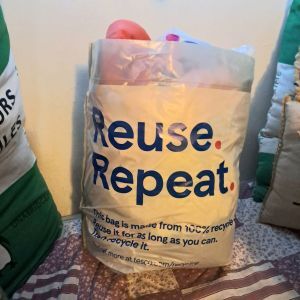 An appropriate slogan for my decluttering mission
An appropriate slogan for my decluttering missionThere are no rules as to how I fill each bag: no systematic sorting by room or by product type. My only proviso is that everything I donate must be saleable.
I realise I’m playing a scaled-up version of Kim’s Game in which players try to remember items removed from a tray of random objects. If I discard only a few things at a time from my jam-packed household, I may even forget what’s gone. Stay in the game for long enough and I’ll ditch a significant quantity of surplus stuff without any sense of loss – perhaps a skip load in a year – and at the same time I’ll raise hundreds of pounds for charity.
Provided I don’t buy more than I dispose of, I’ll be onto a winner. As there’s nothing I need to buy apart from groceries, I’m confident of achieving my objective.
A week later, I’m smug about my progress. I’ve delivered my first three bags to the charity shop. My enthusiasm bolstered by this achievement, I’ve also taken a carload of books to the British Book Rescue, which accepts any number of books in any condition.
This means I’ve created just enough space to accommodate all the good things my aunt gave me from her house: my grandmother’s old French primer…
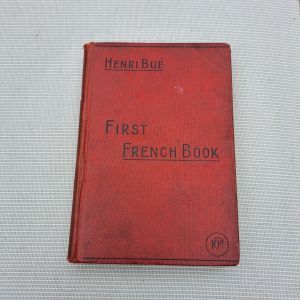 I remember sitting on the floor by her bookshelf poring over this book from when I was very young, years before I started learning French in school. It seemed like a fascinating secret code, none of which I knew how to pronounce.
I remember sitting on the floor by her bookshelf poring over this book from when I was very young, years before I started learning French in school. It seemed like a fascinating secret code, none of which I knew how to pronounce.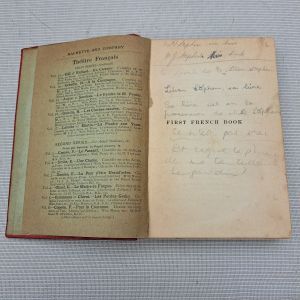 Extra special because it contains evidence of my grandmother’s own study
Extra special because it contains evidence of my grandmother’s own studymy grandfather’s confirmation prayer book…
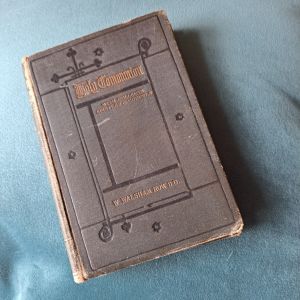 A timely find for me, as I shall be attending confirmation classes myself this autumn
A timely find for me, as I shall be attending confirmation classes myself this autumn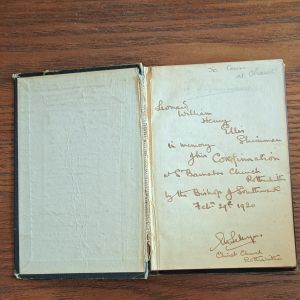 This little book also has a very special inscription on the flyleaf
This little book also has a very special inscription on the flyleafpots my aunt made in her kiln…
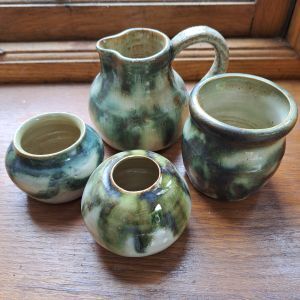 A lovely collection of my aunt’s pottery – all the right size for small bunches of wildflowers from my cottage garden
A lovely collection of my aunt’s pottery – all the right size for small bunches of wildflowers from my cottage garden… and very much more. Ah. I may have spotted a flaw in my plan.
Sneak preview of the first in my BRAND NEW cosy mystery series(launching on 11th October 2024)
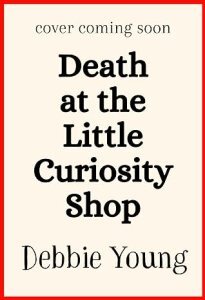 I’ll share the cover image with you as soon as it’s released
I’ll share the cover image with you as soon as it’s releasedWhen Alice Carroll steps into Curiosity Cottage, a picture-perfect former bric-a-brac shop in the Cotswold Village of Little Pride, she thinks she’s found the perfect place to start the new phase of her life. Freshly separated from her collector long-term boyfriend, she’s excited to embrace her new, minimalist existence.
All Alice needs to do is sell off the left-behind stock, and settle in. But the villagers of Little Pride have other ideas, and Alice quickly realises they won’t give up their beloved shop without a fight.
Then a dead body is found buried in her neighbour’s compost heap, and Alice realises there’s much more to Little Pride, and its residents, than meets the eye.
What bestselling authors have said about my previous books:“A cracking example of cozy crime!” Katie Fforde
“An affectionate glimpse of traditional rural English life. The sun shines, the locals gossip, the villagers all come together for the fair. The only problem is a murder. Luckily Sophie is there to solve it. A warm page turner that puts the cosy into cosy mystery. Well worth a read!” T.A. Williams
“Warm and cosy, the Sophie Sayers mysteries are full of likeable and eccentric characters inhabiting the idyllic Cotswold village of Wendlebury Barrow, where gossip, intrigue and murder are rife!” Michelle Salter
Death at the Little Curiosity Shop will be published in all formats and on all the popular platforms on 11th October 2024.
CLICK HERE TO PRE-ORDER YOUR COPY NOW.
June 6, 2024
Learning to be Lazy
A post about my eternal quest for the right work-life balance
When self-employed and working from home, it’s too easy to go to either of two extremes. You work flat out, failing to differentiate between weekdays and weekends, daytime and evening, or you drift about doing housework as a means of procrastination.
When I first started working from home, seven years before COVID made it commonplace, an old friend said to me:
How do you manage to get any work done? I’d be forever putting the laundry on or doing the ironing.
The fact that I gave up ironing around the same time – I possess neither an iron nor an ironing board – indicates which camp I belong to, as does the dust on my bookshelves.
Mindful that we all need regular rest to stay healthy in mind and body, after completing my latest manuscript, I decided to down tools completely for five whole days. The first two were spent on a trip to Bruges with my siblings, and for the remaining three I planned to do absolutely nothing.
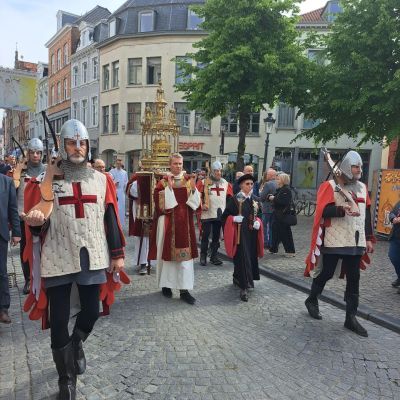 I also managed to travel back in time, seeing the Procession of the Holy Blood in Bruges, which has been taking place at Pentecost ever since 1304 (click image for more details from the Visit Bruges website)
I also managed to travel back in time, seeing the Procession of the Holy Blood in Bruges, which has been taking place at Pentecost ever since 1304 (click image for more details from the Visit Bruges website)The challenge was I don’t know how to do nothing. I am very bad at sitting still, always needing to be doing something, even if it’s only knitting.
Therefore, I decided to do something I never usually do: to try online games on my phone.
As someone who can’t usually stomach video games because they make me feel seasick, I didn’t expect to find a game that would appeal to me. I was surprised to discover not one but a whole range of them, defined as sorting games.
At first that term made me picture toddlers’ shape-sorting toys, and I suppose they’re not that dissimilar. Across the phone screen scroll endless items, as if on a multi-level conveyor belt, reminiscent of The Generation Game, for those old enough to remember it. When you rearrange the objects into matching groups of three, they disappear. You must clear the conveyor belt before the timer pings. I found these games surprisingly addictive, and the time flew by as I kept thinking, “Just one more round, then I’ll stop”.
At first, I couldn’t understand why this simple exercise should be so satisfying. Then I realised I was responding to a basic human need to create order out of chaos.
Doing so on my phone was much easier than decluttering my house – a task long overdue that I’d promised myself I’d do once I’d finished the manuscript. After living in the same house for 33 years, there is an awful lot of clutter to de-.
But now my conscience has got the better of me. My five rest days are up, I’ve put the games on hold, and I’ve started to declutter my house in earnest. So far, I’ve done two kitchen cupboards and my wardrobe rails, and I feel so much lighter for it.
My only disappointment is that none of the stuff comes in satisfying groups of three.
(This post first appeared in the Hawkesbury Parish News, June 2024 edition.)
Coming SoonNEW COZY MYSTERY TRILOGY
 A clue as to the setting of my new cozy mystery trilogy
A clue as to the setting of my new cozy mystery trilogyDecluttering is a theme in my next novel, due to be published a little later this year. The exact title and publication date are yet to be confirmed, but it’ll be the first in a brand-new trilogy of cosy mysteries set in the Cotswolds, in a village not far from Wendlebury Barrow and St Bride’s School, the settings for my other two mystery novel series. The manuscript is currently with Rachel, my editor at Boldwood Books, and she’s also asked me for an outline for books two and three, which I am really looking forward to writing. More news on that project soon!
READERS’ CLUB NEWSLETTER
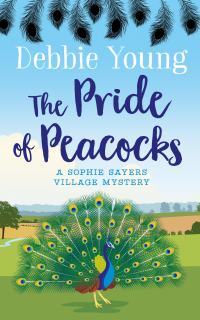 This cozy mystery novella is available exclusively for my Readers’ Club.
This cozy mystery novella is available exclusively for my Readers’ Club.I’ll also be writing a newsletter shortly to members of my Readers’ Club, with exclusive news and photos. If you haven’t yet signed up, click here to add your name to my mailing list, and you’ll receive a free download of the ebook of my novella, The Pride of Peacocks, which is not available anywhere else!
May 29, 2024
In Conversation with Novelist Jane Davis About Her Latest Novel, “The Bookseller’s Wife”
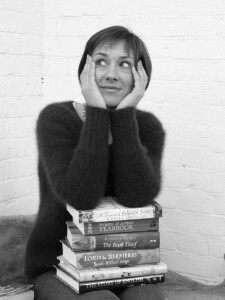 Jane Davis (photo by Matthew Martin)
Jane Davis (photo by Matthew Martin)Throughout 2024, my last blog post of each month will be a conversation with one of my author friends, talking about an aspect of their writing life that I hope will interest my readers too.
When I heard that my author friend Jane Davis was writing a novel about bookselling in late eighteenth-century London, I couldn’t wait to read it. I’m passionate about booksellers, intrigued by the book trade and its history, and I’m a Londoner – so I knew before I read it that I’d love The Bookseller’s Wife. I’m delighted to welcome Jane to my blog today to tell us more about the story behind the novel and the history of the bookselling trade.
Debbie: Jane, what was your inspiration and starting point for the story?
Jane: In September 2022 I took a small research trip to the ancient church of St Mary’s in Merton. Small, because it’s only a ten-minute walk from the house I grew up in. My intention was to visit the place where Nelson worshipped and see his custom-made bench, now heavily alarmed, but which one of my aunts was given special permission to sit on when she was a seven-year-old bridesmaid at her sister’s wedding. Walking among the gravestones, one caught my eye.
DORCAS, WIFE OF J LACKINGTON
Bookseller, Finsbury Square
Died January 27th 1795, aged 46 years.
What could be more intriguing? I read in the church guide that Dorcas was an avid reader of novels and took a leading share in running her husband’s book shop – The ‘Temple of the Muses,’ Finsbury Square. I had to know more!
Debbie: Bookshops are a perennially popular topic for fiction, both contemporary and historical – which I’m glad about, because I love reading (and writing) about them!
Jane: I think that when people think of books about bookshops, the first that springs to mind is 84 Charing Cross Road by Helene Hanff. But there is certainly a spate of novels riding high in charts. The Bookseller of Kabul by Åsne Seierstad and The Bookseller of Inverness by S.G. MacLeanthe are two examples.
(You’ll find a long list of such books at the foot of this post).
Debbie: But you write of an era when bookshops were very different to how they are now. What are the biggest differences?
Bookshops were multi-faceted. Some booksellers were also publishers. Reprinting bestsellers that were out of copyright was a low-risk strategy and gave them a ready supply of stock.
Debbie: Interesting – there are quite a few publishers doing that now on Amazon too! Plus ça change….
Jane: But through their own taste and a sense of what their customers wanted, booksellers also bought manuscripts and published new works, which they sold alongside second-hand books. Some shops also incorporated circulating libraries and if they didn’t, then they might loan books to readers for a small fee. In fact, in an age when books were expensive and customers expected to be offered credit, it was this ready-money (cash) side of the business that kept many a bookseller afloat.
Debbie: We always like to think that our age is the most advanced, and our generation probably considers the rise of the ebook and of digital printing and delivery as the most important breakthroughs in twenty-first-century bookselling . What was cutting edge in terms of books and printing in the late eighteenth-century, when your book is set?
Jane: With population and literacy rates increasing over the course of the century, there was a growing audience for books.
Although the term ‘novel’ had been in use since the sixteenth century, it is the eighteenth century that’s associated with the birth of novel.
Before then, there had only been a scattering of publications that modern readers might recognise as novels. It wasn’t until 1799 that one hundred novels would be published in a single year.
Note that the rather sniffy definition Dr Johnson offered of ‘novel’ for in his famous dictionary was ‘a small tale, generally of love,’ suggesting that the serious-minded reader might prefer histories or tales of travel.
But there had also been a trend for the publication of private dairies and letters, sometimes to scandalous effect. It is no accident that writers like Aphra Behn wrote novels in the form of letters, claiming that they were ‘found text.’
Debbie: In our time, books are pretty affordable for everyone, whether buying ebooks, print, audio, or second-hand. There are even free community libraries, as inspired by the Little Free Library movement. (As you know, I have one of those on my front garden wall and in my village bus stop!) How common was book ownership in the era of your book’s setting?
Jane: The cost of new books was beyond most people’s reach. If we compare it to the cost of a week’s rent on a room – one shilling and six pence – to buy all volumes of a single novel might cost 12 shillings. At between 12 and 21 shillings a year, even the cost of subscribing to a London circulating library was prohibitive.
Attempts were made to make new books affordable by publishing them as collectable volumes, and just as today, after initial print runs had sold out, cheaper duodecimo (12 pages to a printing sheet) editions might be issued, but they would still cost a month’s rent. Readers might opt for abridged or pirated versions, or one of the numerous unofficial spin-offs.
 A perennial classic ever since
A perennial classic ever sinceBut novels such as Robinson Crusoe and Moll Flanders were also serialised in newspapers and magazines, and it was possible to go to a coffee-house and read – although coffee-houses didn’t tend to welcome women.
There was also a flourishing trade in second-hand books. James Lackington – the bookseller in my story – tells us in his memoir that when he was a journeyman shoe-maker he would often forego meals so that he could buy books. This tells us that working people could own books, but they would have to make sacrifices to do so.
Debbie: Dorcas’s background explains her love of books and the access she’s had to them from a young age – but what was the level of literacy like in those days for men and women?
Jane: Because the definition of literacy was a person who could read and write their own name (wow! – D.), we only have best estimates of what we would consider as literacy. Rates would have been far higher in London than elsewhere, but David Cressy estimates that in 1740, 58% of men and 32% of women were literate, and by 1800 this had increased to 60% of men and 40% of women.
Since there was no state school provision, the majority of children were reliant on charity schools or Sunday Schools, which enjoyed a surge in the second half of the century. But like James Lackington, others were self-taught or taught by their first employers.
That said, stories have always been with us and story-telling was a social activity. What we see is a change from the oral tradition to reading aloud. All that was needed was one child who could read, and the whole family could benefit.
There is a rather nice anecdote about a blacksmith who read Richardson’s “Pamela” to a large audience of villagers, and when he reached the part where the hero and heroine were brought together his audience was so delighted that they rang the bells in the village church.
Debbie: As a bell ringer myself, I can relate to that! What fun! So how did you undertake your research? What most surprised/shocked/delighted you about what you discovered?
Jane: As always with historical research, it’s easier to find information about a man than a woman, and so I turned first to her husband. James Lackington left us with two memoirs, written primarily to promote himself as a successful entrepreneurial innovator in the world of bookselling. While his writing must be taken with a liberal pinch of salt, there is substance in dates and key events.
James Lackington’s memoirs tell us that Dorcas’s mother, Jemima Turton, was grand-daughter of the Honourable Sir John Turton, Baron of the Exchequer and Justice of the King’s Bench.
She was so proud of her lineage that she kept her maiden name in the only way a woman could – by marrying a man with the same surname, possible a cousin.
Since Samuel had a fortune of his own, the family should have been comfortably off, but owing to ‘an unhappy turn for gaming,’ he was forced to turn to trade. Even after setting himself up as a saddler’s ironmonger, he couldn’t give up gambling. These days we would recognise addiction rather than weakness of character.
Jemima Turton didn’t live to see her husband’s financial ruin, dying in early 1773. Dorcas then supported her father, setting up a day-school for girls and taking in needlework. Once I read that, I could see this very strong character emerging.
Debbie: How revolutionary was Dorcas’s attitude to women’s education?
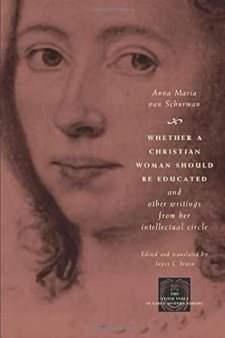 Still available to buy on Amazon!
Still available to buy on Amazon!Jane: I have no evidence that Dorcas championed women’s education. What I do know is that her lived experience mirrors Mary Wollstonecraft’s, and Mary published her Thoughts on the Education of Daughters which was considered radical. I don’t think it is too far a stretch of the imagination that Dorcas would have shared her views. Mary was by no means the first to advocate for education for women.
A seventeenth century Dutch woman Anna Maria Schurman, who was allowed to attend Utrecht University as long as she sat behind a curtain (!), wrote “Whether a Christian Woman Should Be Educated” arguing in favour.
But we have to remember that it wasn’t a simple distinction between education for sons and daughters. This was a time when the idea of free education for all was radical. The majority believed that children should only be educated as far as was necessary for their station in life (which was, of course, fixed at birth). Some went as far as to say that it was cruel to teach children more.
Debbie: You usually write standalone books, but you’re already working on the sequel to this one – what compelled you to continue Dorcas’s story?
Jane: Simply that there is more to tell.
Debbie: I can’t wait to read the next instalment! Thank you very much, Jane, for being my guest today.
More About The Bookseller’s Wife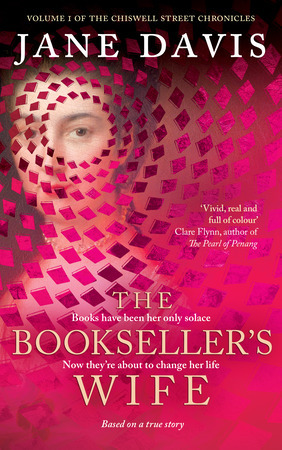 London, 1775: The only surviving child of six, Dorcas Turton should have been heiress to a powerful family name. But after her mother’s untimely death, she is stunned by the discovery that her father’s compulsive gambling has brought them close to ruin. With the threat of debtor’s prison looming large, she must employ all her ingenuity to keep their creditors at bay.
London, 1775: The only surviving child of six, Dorcas Turton should have been heiress to a powerful family name. But after her mother’s untimely death, she is stunned by the discovery that her father’s compulsive gambling has brought them close to ruin. With the threat of debtor’s prison looming large, she must employ all her ingenuity to keep their creditors at bay.
Fortunately, ingenuity is something Dorcas is not short of. An avid reader, novels have taught her the lessons her governess failed to. Forsaking hopes of marriage and children, she opens a day-school for girls. But unbeknown to Dorcas, her father has not given up his extravagant ways. When bailiffs come pounding on the door, their only option is to take in lodgers.
The arrival of larger-than-life James Lackington and his wife Nancy breathes new life into the diminished household. Mr Lackington aspires to be a bookseller, and what James Lackington sets out to do, he tends to achieve. Soon Dorcas discovers she is not only guilty of envying Mrs Lackington her strong simple faith and adaptable nature. Loath though she is to admit it, she begins to envy her Mr Lackington…
Based on a true story, Jane Davis’s latest historical novel is for book-lovers everywhere, delivering unforgettable characters, a portrait of Georgian London on the brink of change, and a love song to the life-changing power of the written word.
More About Jane DavisJane Davis’s first novel, Half-Truths and White Lies, won a national award established with the aim of finding the next Joanne Harris. Further recognition followed in 2016 with An Unknown Woman being named Self-Published Book of the Year by Writing magazine/the David St John Thomas Charitable Trust, as well as being shortlisted in the IAN Awards, and in 2019 with Smash all the Windows winning the inaugural Selfies Book Award. Her novel At the Stroke of Nine O’Clock was featured by The Lady magazine as one of their favourite books set in the 1950s, selected as a Historical Novel Society Editor’s Choice, and shortlisted for the Selfies Book Awards 2021.
Interested in how people behave under pressure, Jane introduces her characters when they are in highly volatile situations and then, in her words, she throws them to the lions. The themes she explores are diverse, ranging from pioneering female photographers, to relatives seeking justice for the victims of a fictional disaster.
Jane Davis lives in Carshalton, Surrey, in what was originally the ticket office for a Victorian pleasure gardens, known locally as ‘the gingerbread house.’ Her house frequently features in her fiction. In fact, she burnt it to the ground in the opening chapter of An Unknown Woman and in Small Eden it was the gardener’s cottage.
When she isn’t writing, you may spot Jane disappearing up the side of a mountain with a camera in hand.
Find out more about Jane on her website: www.jane-davis.co.uk. If you join her mailing list there, you’ll receive a free ebook of I Stopped Time.Order The Bookseller’s Wife from your preferred store here
Other Novels about Bookshops and BooksellersThe Love Island Bookshop by Kate FrostThe Bookshop Murder by Merryn AllinghamA Wartime Welcome from the Bookshop Girls by Elaine RobertsCan’t Take My Eyes Off You by Aimee BrownSummer at the Santorini Bookshop by Rebecca RaisinThe Missing Bookshop by Patricia McBrideThe Hopes and Dreams of Libby Quinn by Claire AllanLove Blooms at Mermaid Point by Sarah BennettMurder in the Bookshop by Anita DavisonIt Started with a Book by Camilla IsleyThe Girls Next Door by Anita WallerAn Enchanted Moment on Ever After Street by Jaimie AdamsJust for the Summer by Fay JessopTo the Fair Land by Lucienne BoyceThe Mayfair Bookshop by Eliza KnightThe Bookshop by Penelope FitzgeraldThe Bookseller of Kabul by Åsne SeierstadThe Bookseller of Inverness by S.G. MacLeanThe Bookshop on Primrose Hill by Sarah JioDeath of a Bookseller Alice SlaterA Bookshop in Paris by Ellen FeldmanThe Bookbinder by Pip WilliamsYellowface by Rebecca F KuangBookshops & Bonedust by Travis BaldreeThe Door-to-Door Bookstore by Carsten HennThe Lost Bookshop by Evie WoodsThe Paris Bookseller by Kerri MaherMr Penumbra’s 24-hour Bookstore by Robin SloanDays at the Morisaki Bookshop by Satoshi YagisawaThe Lost Bookshop by Evie WoodsThe Bookseller’s Tale by Ann SwinfenThe Bookseller by Cynthia SwansonThe Bookseller’s Daughter by Pam RosenthalThe Bookseller’s Daughter by Daniela SacerdotiThe Bookseller’s Daughter by Christine StablesThe Bookseller of Dachau by Shari J. RyanThe Wartime Bookshop by Lesley EamesThe Last Bookshop in London by Madeline MartinThe London Bookshop Affair by Louise FeinThe Forgotten Bookshop in Paris by Daisy WoodThe Mayfair Bookshop by Eliza KnightDiary of a Tuscan Bookshop by Alba DonatiThe English Bookshop by Janis WildyThe Printed Letter Bookshop by Katherine ReayWelcome to the Hyunam-dong Bookshop by Hwang Bo-reumThe Bookbinder’s Daughter by Jessica ThornThe Bookbinder of Jericho by Pip WilliamsThe Bookshop of Secrets by Mollie RushmeyerThe Bermondsey Bookshop by Sarah GibsonThe Bookseller’s Secret by Michelle GableThe Banned Bookshop of Maggie Banks by Shauna RobinsonThe Haunted Bookshop by Christopher MorleyThe Printed Letter Bookshop by Katherine ReayThe Left-handed Booksellers of London by Garth NixThe Bookseller by Cynthia SwansonThe British Booksellers by Kristy CanbronThe Bookseller of Florence by Ross KingThe Bookshop on the Shore by Jenny ColganBloomsbury Girls by Natalie JennerThe Forgotten Bookshop of Paris by Daisy WoodAnd many more… including my Sophie Sayers Cozy Mystery series, all of which feature the village bookshop where Sophie works, Hector’s House, and its proprietor (and eventually Sophie’s boyfriend) Hector Munro:
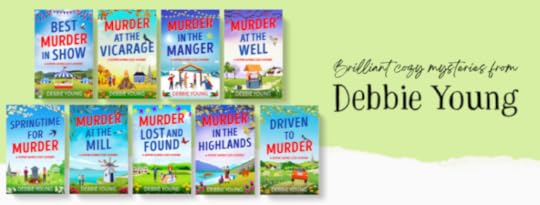
How many of this list of books about bookshops have you read? Can you think of any more? We’d love to know!
May 15, 2024
Singing Together: Musical Memories from Primary School
Isn’t it odd how snippets of song lyrics lurk in our memories decades after we learned them? I may not be able to remember where I parked my car at Yate Shopping Centre, but I’m still word perfect on songs I learned at primary school.
So, when my author friend Stefania Hartley told me about Ride Like a Gaucho, Tetbury young farmer Sophia Ashe’s memoir of her gap year in Argentina, I was transported not to South America, but to my Year 3 classroom in a Terrapin hut of Days Lane Primary School, Sidcup, and our weekly Singing Together lesson. In my head I immediately started singing:
“See the gaucho, ride the pampas, Ride the pampas, green and wide…”
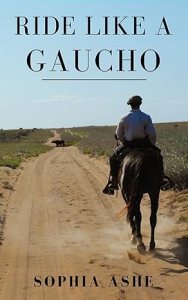 Sophia Ashe’s book taught me so much more about gauchos!
Sophia Ashe’s book taught me so much more about gauchos!Singing Together was a weekly BBC radio programme for schools, broadcast nationwide from 1939 until 2004. In the days before audio streaming and BBC Sounds, all the schools taking part had to tune in to the live broadcast. We sang along with the show’s hosts and their backing choir, and sometimes we played our recorders too.
There was something very exciting about knowing we were singing the same songs at the same time as thousands of children all over the country.
Each term we learned a mix of folk songs from around the world, set down in printed booklets, which the schools had to buy. The songs ranged from lilting melodies to rousing calypsos to nonsense songs. We thought it great fun, not realising the many educational benefits we were absorbing in the process: learning to read music, improving our literacy skills, working as a team, and building our awareness of other cultures. Gaucho! Pampas! Such exotic words!
Singing Together was also very levelling. We weren’t marked or judged on their performance, and the subject didn’t feature in our school report. We simply enjoyed ourselves.
In those days we sat in neat rows at old-fashioned single wooden desks with lift-up lids. For Singing Together, we had to move our desks together in pairs, because there were only enough booklets for one between two. At the end of term, we were allowed to buy the booklets for sixpence each, on a first-come, first-served basis. Throughout primary school, I went to my grandma’s for school dinners. I remember cadging sixpence off her at the end of each term and running back to school as soon as we’d finished eating to secure my copy. The songs we learned are still very special to me.
Sadly, I don’t still have my copies of those booklets – but you can click here to see the BBC’s gallery of Singing Together booklet covers.
It’s unfortunate that few of the live radio programmes were recorded, and almost all have been lost. Whether or not you remember taking part in Singing Together, you might enjoy listening to a wonderful radio documentary by Jarvis Cocker, which you can catch on BBC Sounds here: https://www.bbc.co.uk/programmes/b04stc6c
I bet you can’t listen without joining in at some point! If the programme makes you hanker after a grown-up equivalent of Singing Together, try joining your local choir (Hawkesbury Choir, in my case) – it ticks all the same boxes for me!
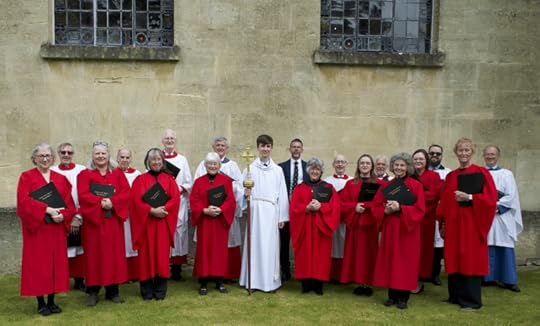 Singing with my village choir is a source of great joy and camaraderie to me now. We’re pictured here outside Great Badminton church, after singing there during the Badminton Horse Trials. I’m in the front row on the left. (Choir photos by Sir Ian Macfadyen)
Singing with my village choir is a source of great joy and camaraderie to me now. We’re pictured here outside Great Badminton church, after singing there during the Badminton Horse Trials. I’m in the front row on the left. (Choir photos by Sir Ian Macfadyen)This article first appeared in the May 2024 edition of the Hawkesbury Parish News
May 8, 2024
Confessions of a Reluctant Murderer: My Guest Post for Helen Hollick
Helen Hollick is one of my longest-standing author friends. When we met at an event organised by SilverWood Books back in 2012 (see photo above), we immediately hit it off, and have been in regular contact ever since, despite living a couple of counties apart – Helen in her idyllic farmhouse in Devon, me in a village in the Cotswolds. She’s also been a frequent guest on my blog. (See links to some of her previous posts for me at the foot of this one.)
Helen is a long-established, prolific and versatile author, starting out as a historical novelist, sidestepping into historical pirate-themed fantasy, history books, and most recently cosy mysteries. Her Jan Christopher Mystery series is set between 1970s Essex and Devon and features a young librarian and her police officer fiancé. It’s a gentle, feel-good read, and for those of us old enough to remember the 1970s, it’s enjoyable nostalgic too.
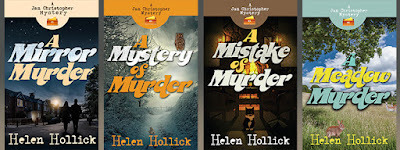 The first four books in Helen Hollick’s cozy mystery seriesIntroducing the fifth Jan Christopher Mystery
The first four books in Helen Hollick’s cozy mystery seriesIntroducing the fifth Jan Christopher Mystery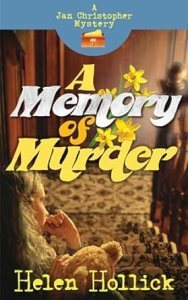 The fifth in Helen’s series will launch on 18th May
The fifth in Helen’s series will launch on 18th MayThis month Helen will launch the fifth in her series, A Memory of Murder, featuring “a missing girl, annoying decorators, circus performers, and a wanna-be rock star” – and harking back to the murder of Jan’s police officer father fifteen years earlier…
In the run-up to the publication of A Memory of Murder, Helen is running a special mystery week on her blog, with a new post every day by a different crime writer.
I was honoured to be the first on her agenda, and I’m sharing the opening of my guest post for her below. Click the link at the bottom to read the rest of the post on her blog.
CONFESSIONS OF A RELUCTANT MURDERER
(My guest post for Helen Hollick’s Mystery Week on her blog)
To murder or not to murder, that is the question…
‘I don’t really like murdering people,’ I once said in a public place when chatting to writer friends, startling innocent bystanders unaware of our occupation.
Of course, I was speaking about murdering fictitious characters in my books. In real life I find it hard to kill as much as a fly. This may surprise you when you hear I’m an author of murder mystery novels.
Click here to read the rest of my guest post on Helen Hollick’s blog
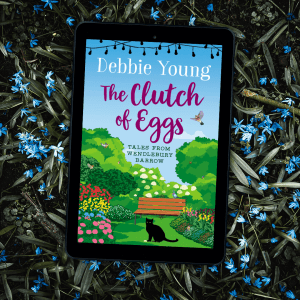 One of my murder-free mystery novelettes
One of my murder-free mystery novelettes
May 1, 2024
Talking Rhubarb
As a fair-weather gardener, I’m only now emerging from hibernation to tame the garden for the summer.
In my personal horticultural calendar, I have a limited window for tackling weeds. If I haven’t got my plot under control by the start of September, I give up. I know nature will soon side with me and stop the weeds growing in winter. I’m in awe of anyone who gardens all year round. I don’t venture out until dock leaves dwarf fading tulips and dandelions dominate the lawn.
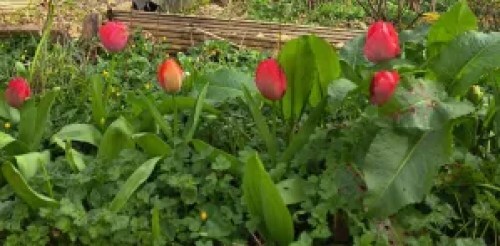
By this time, the task of clearing the weeds seems overwhelming. But it doesn’t take much to lift my spirits. Discovering bright bouquets of rhubarb quietly colonising the vegetable patch does the trick. (Technically, rhubarb is a vegetable, not a fruit.) Lime-green leaves unfurling from blush-pink stems send a welcome semaphore message: “It’s crumble time!”
 One of four clumps of rhubarb growing in my vegetable patch
One of four clumps of rhubarb growing in my vegetable patchWe’ve long since exhausted our frozen stocks of last year’s apples, plums, and pears. This year’s crop of tree fruit is still months away, and the apple trees haven’t even started blossoming yet. So, this copious crop of rhubarb, ripe for pulling, is a welcome sight indeed. There’s enough here to keep us going for months of Sunday lunches.
Rhubarb offers a generous return on very little labour. The only maintenance it requires is the division of its crowns and the occasional feed. It’s a bonus that the vast leaves, though poisonous to eat, make a useful addition to the compost heap.
In my Cotswold garden, rhubarb is so easy to grow that I’m surprised it’s not native to Britain. It didn’t reach Europe until the fourteenth century, first via the Silk Road and later from Russia. This long journey made rhubarb an expensive status symbol, alongside silks and spices.
Ironic, then, that its name has become a slang word for “rubbish”, as in “You’re talking rhubarb”. Why be so rude about rhubarb?
The answer lies in the traditional use of the word on stage in crowd scenes. It’s a very soft word, as shapeless and slithery as stewed rhubarb. (Unlike carrot or potato, for example.) When we hear actors mumble “rhubarb, rhubarb”, we know they’re saying something, but we can’t make out what. We recognise the chattering of the crowd, but we’re not distracted by meaning.
In 1970 Eric Sykes celebrated the tradition with his television comedy special, Rhubarb. Its only dialogue is the repetition of the word “rhubarb” – surely the easiest lines any actors have ever had to learn. He made a second version ten years later, called Rhubarb Rhubarb.
It seems I’m not the only person who can’t have too much rhubarb.
This post first appeared in the Tetbury Advertiser’s May 2024 edition.

